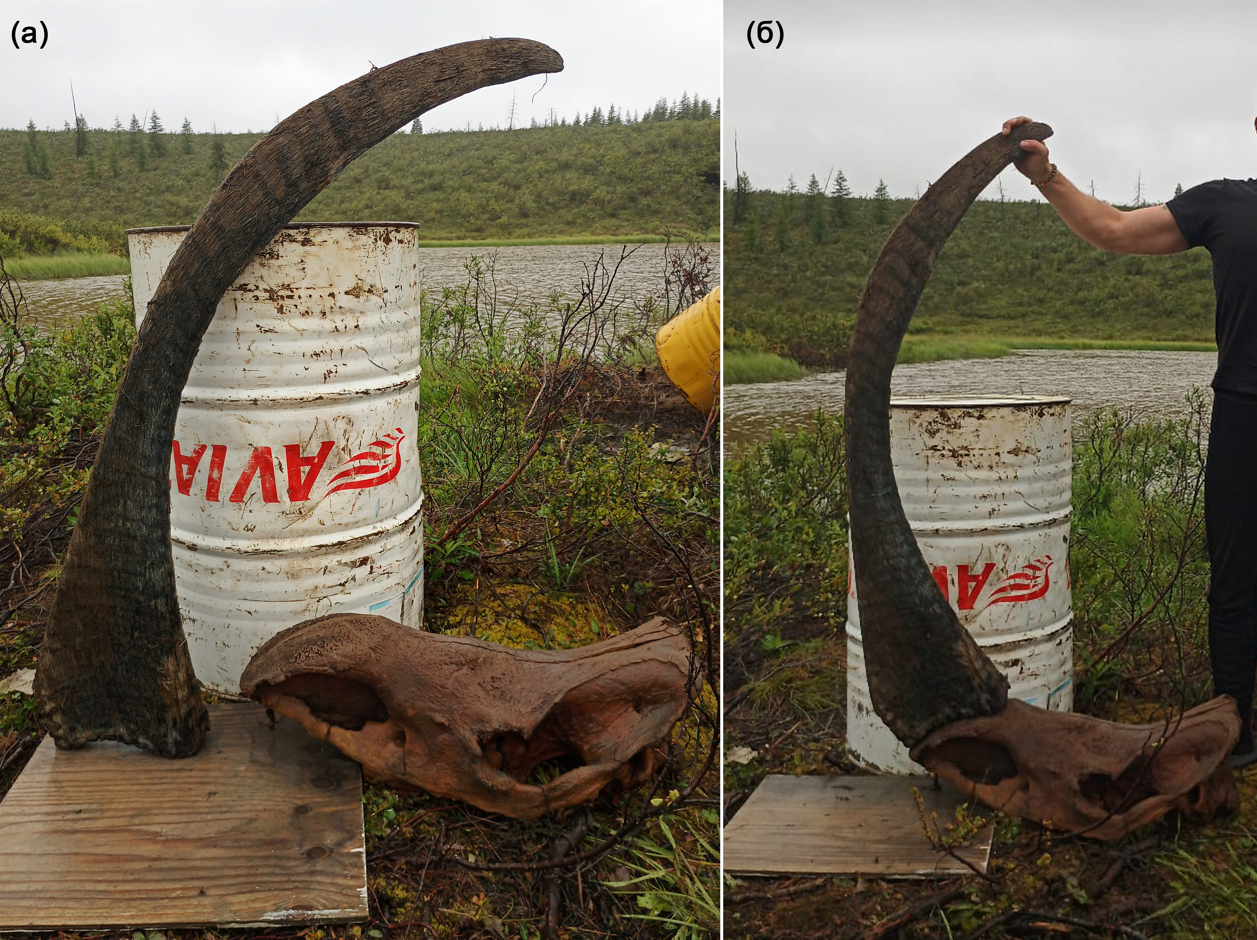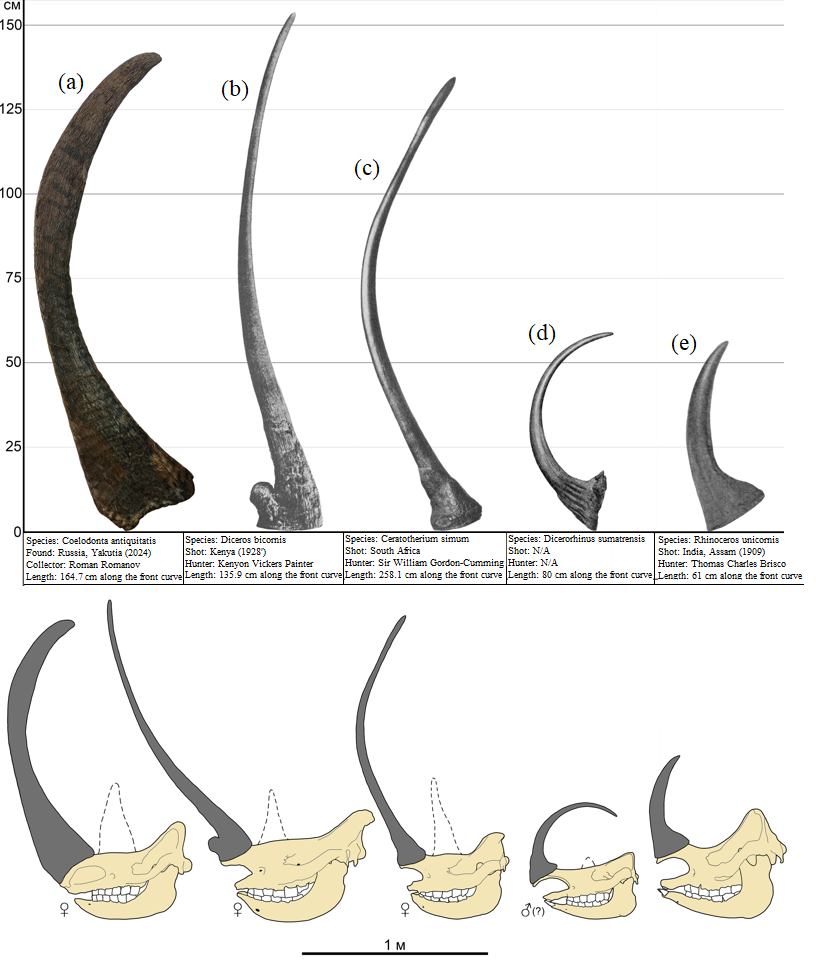
In a joint article published in the Journal of Zoology, Ruslan Belyaev and Natalia Prilepskaya, researchers from the Laboratory of Ecology, Physiology, and Functional Morphology of Higher Vertebrates at the A.N. Severtsov Institute of Ecology and Evolution of the Russian Academy of Sciences (IEE RAS), along with colleagues from Yakutia led by Gennady Boeskorov (DPMGI SB RAS), analyzed the horn size of woolly rhinoceroses (Coelodonta antiquitatis) found in permafrost in Yakutia. Combining information from previously described horns and new finds studied in recent years, the authors analyzed a sample of 47 anterior (nasal) horns from adult woolly rhinoceroses, described the longest horn known to date, and recorded a record for longevity in Coelodonta antiquitatis.
Rhino horns are a unique structure. They lack a bony core and, like hair, nails, and hooves, are a derivative of skin composed of keratin. The horn is formed from numerous keratin tubes (filaments) embedded in a keratin matrix. They are attached to the nasal and frontal bones (if a frontal horn is present) of the skull by a layer of connective tissue and ligaments.

Thanks to permafrost preservation, numerous Russian museums have amassed a vast collection of woolly rhinoceros fossil horns. These finds date primarily to the second half of the Late Pleistocene and are tens of thousands of years old. A new study has shown that the nasal horn length of adult (over 15 years) woolly rhinoceroses averaged over 1 meter (with an average age in the sample of approximately 24 years). This is almost twice as long as the average length of the front horns of the white rhinoceros (55-60 cm) and 2.5-5 times longer than the horns of other modern rhinoceros species. A woolly rhinoceros horn discovered in 2024 on the banks of the Mustur-Yuryuye River turned out to be the longest rhinoceros horn known to date. Its length along the anterior curvature is 164.7 cm. This is 30.7 cm longer than the second-longest horn of Coelodonta antiquitatis and 6.6 cm longer than the longest known horn of a modern rhinoceros, which belonged to a female white rhinoceros shot over a century ago in South Africa (Figure 2). Like all nasal horns of woolly rhinoceroses, this horn is arched and curved significantly backward. Because of this, its length along the anterior curvature exceeds, and between the extreme points of the base and apex is shorter than the practically straight, when viewed from the side, record-breaking horn of the modern white rhinoceros (Figure 2). The mass of the anterior horns of the woolly rhinoceros was also greater than that of modern species. On average, the nasal horn of an adult woolly rhinoceros weighs just over 6 kg. This is slightly more than the average weight of the nasal horn of the white rhinoceros (just over 5 kg) and 3.5-11 times heavier than the horns of other modern rhinoceros species.
The record-breaking horn was found along with a skull on the Mustur-Yuryuye River. Despite the horn's enormous size, the skull of this specimen was quite small (approximately 73 cm in length). Since the woolly rhinoceros, like modern rhinoceroses, exhibited pronounced sexual dimorphism in body size and weight, this suggested that the record-breaking horn belonged to a female woolly rhinoceros. Interestingly, the record-breaking horns of modern African rhinoceroses (black and white) also belonged to females. However, the average horn length in African species is somewhat longer in males.
Besides its record-breaking length, the horn from the Mustur-Yuryuye River was also unique in terms of the individual age of the animal – it belonged to the oldest woolly rhinoceros specimen known to date. A rhinoceros' horn is a recording structure and has a layered structure. Rhinoceros horn growth begins at its base, extending from the dermis in successive horny plates approximately 1-2 mm thick. The oldest layers are located at the apex of the horn, and the only layer of 'living' tissue is the youngest (growing) plate, which has not yet lost its connection with the epidermis. The horn's layered structure is manifested by alternating lighter and darker transverse growths (zones) of keratin. In modern rhinoceroses, the sequence of these growths can be studied using tomography or horn dissection; however, in woolly rhinoceroses, by destroying the outer keratin layers, the alternation of growths becomes clearly visible without additional surgical intervention. Annual horn growth consists of two zones: lighter, denser keratin and darker, looser keratin. The number of annual layers in horn correlates well with the number of annual layers in another recording structure—dental cementum. This confirms the reliability of using annual layers in horn to determine the individual age of an animal. The horn found on the Mustur-Yuryuye River contains 40-41 annual layers, indicating an individual age of over 40 years. Since rhinos can completely erase the growths formed in youth, this individual's age at death may have been even slightly older. An age over 40 years corresponds to the longest lifespan for modern rhinos kept in captivity.
A study of the discovery was published in the Journal of Zoology: Gennady G. Boeskorov, Maksim Yu. Cheprasov, Gavril P. Novgorodov, Marina V. Shchelchkova, Natalya E. Prilepskaya & Ruslan I. Belyaev (2025) The longest known rhino horn from the permafrost of Yakutia offers insights into woolly rhinoceros morphology, paleocology, and sexual dimorphism.
Related materials:
Science.Mail: "Longest Ancient Rhinoceros Horn Found in Yakutia"
Science.RF: "Longest Rhinoceros Horn Found in Yakutia's Permafrost"
RAS: "Longest Rhinoceros Horn Found in Yakutia's Permafrost"
AV-News: "165-Centimeter Woolly Rhinoceros Horn from Yakutia Records Species' Maximum Age and Size"
RS-News: "Longest Woolly Rhinoceros Horn Ever Found in Yakutia's Permafrost"
Baikal.Daily: "Longest Rhinoceros Horn Found in Yakutia"
ArcticUniverse: "Unique Discovery Made in Yakutia's Permafrost" Science Index: "Longest Rhinoceros Horn Found in Permafrost of Yakutia"
